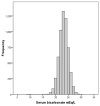Low serum bicarbonate and kidney function decline: the Multi-Ethnic Study of Atherosclerosis (MESA)
- PMID: 24953891
- PMCID: PMC4177290
- DOI: 10.1053/j.ajkd.2014.05.008
Low serum bicarbonate and kidney function decline: the Multi-Ethnic Study of Atherosclerosis (MESA)
Abstract
Background: Among populations with established chronic kidney disease (CKD), metabolic acidosis is associated with more rapid progression of kidney disease. The association of serum bicarbonate concentrations with early declines in kidney function is less clear.
Study design: Retrospective cohort study.
Setting & participants: 5,810 participants in the Multi-Ethnic Study of Atherosclerosis (MESA) with a baseline estimated glomerular filtration rate (eGFR) > 60mL/min/1.73 m(2) using the CKD-EPI (CKD Epidemiology Collaboration) creatinine-cystatin C equation.
Predictors: Serum bicarbonate concentrations.
Outcomes: Rapid kidney function decline (eGFR decline > 5% per year) and incident reduced eGFR (eGFR < 60mL/min/1.73 m(2) with minimum rate of eGFR loss of 1 mL/min/1.73 m(2) per year).
Results: Average bicarbonate concentration was 23.2 ± 1.8mEq/L. 1,730 (33%) participants had rapid kidney function decline, and 487 had incident reduced eGFR during follow-up. Each 1-SD lower baseline bicarbonate concentration was associated with 12% higher adjusted odds of rapid kidney function decline (95% CI, 6%-20%) and higher risk of incident reduced eGFR (adjusted incidence rate ratio, 1.11; 95% CI, 1.03-1.20) in models adjusting for demographics, baseline eGFR, albuminuria, and CKD risk factors. The OR for the associations of bicarbonate level < 21 mEq/L relative to 23-24 mEq/L was 1.35 (95% CI, 1.05-1.73) for rapid kidney function decline, and the incidence rate ratio was 1.16 (95% CI, 0.83-1.62) for incident reduced eGFR.
Limitations: Cause of metabolic acidosis cannot be determined in this study.
Conclusions: Lower serum bicarbonate concentrations are associated independently with rapid kidney function decline independent of eGFR or albuminuria in community-living persons with baseline eGFR > 60 mL/min/1.73 m(2). If confirmed, our findings suggest that metabolic acidosis may indicate either early kidney disease that is not captured by eGFR or albuminuria or may have a causal role in the development of eGFR < 60 mL/min/1.73 m(2).
Keywords: Serum bicarbonate; chronic kidney disease (CKD); disease progression; kidney disease trajectory; kidney function; metabolic acidosis; renal disease.
Copyright © 2014 National Kidney Foundation, Inc. Published by Elsevier Inc. All rights reserved.
Figures


Comment in
-
Metabolic Acidosis as a Possible Cause of CKD: What Should Clinicians Do?Am J Kidney Dis. 2014 Oct;64(4):481-3. doi: 10.1053/j.ajkd.2014.08.005. Am J Kidney Dis. 2014. PMID: 25257321 No abstract available.
Similar articles
-
Serum bicarbonate concentrations and kidney disease progression in community-living elders: the Health, Aging, and Body Composition (Health ABC) Study.Am J Kidney Dis. 2014 Oct;64(4):542-9. doi: 10.1053/j.ajkd.2014.05.009. Epub 2014 Jun 18. Am J Kidney Dis. 2014. PMID: 24953890 Free PMC article.
-
Metabolic acidosis is associated with increased risk of adverse kidney outcomes and mortality in patients with non-dialysis dependent chronic kidney disease: an observational cohort study.BMC Nephrol. 2021 May 19;22(1):185. doi: 10.1186/s12882-021-02385-z. BMC Nephrol. 2021. PMID: 34011303 Free PMC article.
-
Associations of urinary levels of kidney injury molecule 1 (KIM-1) and neutrophil gelatinase-associated lipocalin (NGAL) with kidney function decline in the Multi-Ethnic Study of Atherosclerosis (MESA).Am J Kidney Dis. 2012 Dec;60(6):904-11. doi: 10.1053/j.ajkd.2012.05.014. Epub 2012 Jun 30. Am J Kidney Dis. 2012. PMID: 22749388 Free PMC article.
-
Kidney Function, Albuminuria, and Risk of Incident Atrial Fibrillation: A Systematic Review and Meta-Analysis.Am J Kidney Dis. 2024 Mar;83(3):350-359.e1. doi: 10.1053/j.ajkd.2023.07.023. Epub 2023 Sep 29. Am J Kidney Dis. 2024. PMID: 37777059
-
Effects of dietary interventions for metabolic acidosis in chronic kidney disease: a systematic review and meta-analysis.Nephrol Dial Transplant. 2025 Apr 1;40(4):751-767. doi: 10.1093/ndt/gfae200. Nephrol Dial Transplant. 2025. PMID: 39277780 Free PMC article.
Cited by
-
Low-protein diets for chronic kidney disease patients: the Italian experience.BMC Nephrol. 2016 Jul 11;17(1):77. doi: 10.1186/s12882-016-0280-0. BMC Nephrol. 2016. PMID: 27401096 Free PMC article.
-
Acid Base Balance and Progression of Kidney Disease.Semin Nephrol. 2019 Jul;39(4):406-417. doi: 10.1016/j.semnephrol.2019.04.009. Semin Nephrol. 2019. PMID: 31300095 Free PMC article. Review.
-
Plant-Based Diets and Peritoneal Dialysis: A Review.Nutrients. 2022 Mar 19;14(6):1304. doi: 10.3390/nu14061304. Nutrients. 2022. PMID: 35334961 Free PMC article. Review.
-
Effects of sex, age, and body mass index on serum bicarbonate.Front Sleep. 2023;2:1195823. doi: 10.3389/frsle.2023.1195823. Epub 2023 Jul 20. Front Sleep. 2023. PMID: 37736141 Free PMC article.
-
Urinary stone risk factors in the descendants of patients with kidney stone disease.Pediatr Nephrol. 2018 Jul;33(7):1173-1181. doi: 10.1007/s00467-018-3927-1. Epub 2018 Mar 28. Pediatr Nephrol. 2018. PMID: 29594505
References
-
- Kraut JA, Kurtz I. Metabolic acidosis of CKD: diagnosis, clinical characteristics, and treatment. Am J Kidney Dis. 2005 Jun;45(6):978–993. - PubMed
Publication types
MeSH terms
Substances
Grants and funding
- N01 HC095161/HL/NHLBI NIH HHS/United States
- N01 HC095169/HL/NHLBI NIH HHS/United States
- UL1-RR-024156/RR/NCRR NIH HHS/United States
- UL1 RR024156/RR/NCRR NIH HHS/United States
- N01-HC-95165/HC/NHLBI NIH HHS/United States
- N01 HC095159/HL/NHLBI NIH HHS/United States
- UL1-TR-000040/TR/NCATS NIH HHS/United States
- N01-HC-95160/HC/NHLBI NIH HHS/United States
- N01 HC095163/HL/NHLBI NIH HHS/United States
- R01 HL096875/HL/NHLBI NIH HHS/United States
- 5R01AG027002-07/AG/NIA NIH HHS/United States
- N01-HC-95162/HC/NHLBI NIH HHS/United States
- N01 HC095168/HL/NHLBI NIH HHS/United States
- R01 DK098234/DK/NIDDK NIH HHS/United States
- N01-HC-95163/HC/NHLBI NIH HHS/United States
- N01-HC-95168/HC/NHLBI NIH HHS/United States
- N01-HC-95159/HC/NHLBI NIH HHS/United States
- N01 HC095167/HL/NHLBI NIH HHS/United States
- N01-HC-95169/HC/NHLBI NIH HHS/United States
- N01-HC-95164/HC/NHLBI NIH HHS/United States
- R01 AG027002/AG/NIA NIH HHS/United States
- P30 DK035816/DK/NIDDK NIH HHS/United States
- TL1 TR000144/TR/NCATS NIH HHS/United States
- N01-HC-95161/HC/NHLBI NIH HHS/United States
- 1R01DK098234-01A1/DK/NIDDK NIH HHS/United States
- N01 HC095166/HL/NHLBI NIH HHS/United States
- N01 HC095162/HL/NHLBI NIH HHS/United States
- UL1-TR-001079/TR/NCATS NIH HHS/United States
- N01-HC-95166/HC/NHLBI NIH HHS/United States
- N01 HC095165/HL/NHLBI NIH HHS/United States
- N01 HC095164/HL/NHLBI NIH HHS/United States
- N01-HC-95167/HC/NHLBI NIH HHS/United States
- N01 HC095160/HL/NHLBI NIH HHS/United States
LinkOut - more resources
Full Text Sources
Other Literature Sources
Medical
Research Materials
Miscellaneous

